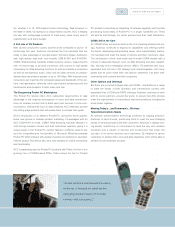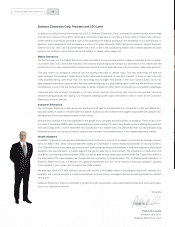Audiovox 2001 Annual Report Download - page 17
Download and view the complete annual report
Please find page 17 of the 2001 Audiovox annual report below. You can navigate through the pages in the report by either clicking on the pages listed below, or by using the keyword search tool below to find specific information within the annual report.
15 Audiovox Corporation and Subsidiaries
rebates as this represents the Company’s full obligation. With respect
to the volume incentive rebates, the customers are required to pur-
chase a specified volume of a specified product. The Company
accrues for the rebate as product is shipped. When specified volume
levels are not achieved, and, therefore, the customer is not entitled to
the funds, the Company revises its estimate of its liability. The accrual
for co-operative advertising allowances, market development funds and
volume incentive rebates at November 30, 2001 was $10.4 million. The
Company continuously monitors the requests made by its customers
and revises its estimate of the liability under these arrangements
based upon the likelihood of its customers not requesting the funds.
The Company’s estimates of amounts requested by its customers in
connection with these arrangements may prove to be inaccurate, in
which case the Company may have understated or overstated the pro-
vision required for these arrangements. In the future, if the liability for
these arrangements is determined to be overstated, the Company
would be required to recognize such additional operating income at
the time such determination is made. Likewise, if the liability for these
arrangements is determined to be understated, the Company would
be required to recognize such additional operating expenses at the
time the customer makes such requests. Therefore, although the
Company makes every effort to ensure the accuracy of its estimates,
any significant unanticipated changes in the purchasing volume of its
customers could have a significant impact on the liability and the
Company’s reported operating results.
Inventories
The Company values its inventory at the lower of the actual cost to pur-
chase and/or the current estimated market value of the inventory less
expected costs to sell the inventory. The Company regularly reviews
inventory quantities on-hand and records a provision for excess and
obsolete inventory based primarily on the Company’s estimated forecast
of product demand. As demonstrated in recent years, demand for the
Company’s products can fluctuate significantly. A significant sudden
increase in the demand for the Company’s products could result in a
short-term increase in the cost of inventory purchases while a significant
decrease in demand could result in an increase in the amount of excess
inventory quantities on-hand. In addition, the Company’s industry is
characterized by rapid technological change and frequent new product
introductions that could result in an increase in the amount of obsolete
inventory quantities on-hand. In such situations, the Company generally
does not obtain price protection from its vendors, however, on occasion,
the Company has received price protection which reduces the cost of
inventory. There can be no assurances that the Company will be suc-
cessful in negotiating such price protection from its vendors in the future.
Additionally, the Company’s estimates of future product demand may
prove to be inaccurate, in which case the Company may have under-
stated or overstated the provision required for excess and obsolete
inventory. In the future, if the Company’s inventory is determined to be
overvalued, it would be required to recognize such costs in its cost of
goods sold at the time of such determination. Likewise, if the Company
does not properly estimate the lower of cost or market of its inventory
and it is therefore determined to be undervalued, it may have over-
reported its cost of goods sold in previous periods and would be
required to recognize such additional operating income at the time of
sale.Therefore, although the Company makes every effort to ensure the
accuracy of its forecasts of future product demand, any significant unan-
ticipated changes in demand or technological developments could have
a significant impact on the value of the Company’s inventory and its
reported operating results. In addition, given the anticipated emergence
of new technologies in the wireless industry, the Company will need to
sell existing inventory quantities of current technologies to avoid further
write-downs to market. In particular, at November 30, 2001, the
Company had on hand 575,000 units of a certain phone model, which,
after write-down, was valued at $75,423. In the near future, the
Company expects to introduce a new model, as well as new technolo-
gies and, therefore, no guarantee can be made that further reductions in
the carrying value of this model or any other models will not be required.
Warranties
The Company offers warranties of various lengths to its customers
depending upon the specific product. The Company’s standard
warranties require the Company to repair or replace defective product
returned to the Company during such warranty period at no cost to the
customer. The Company records an estimate for warranty related
costs based upon its actual historical return rates and repair costs at
the time of sale, which are included in cost of sales. The estimated lia-
bility for future warranty expense amounted to $9.2 million at
November 30, 2001, which has been included in accrued expenses
and other current liabilities. While the Company’s warranty costs have
historically been within its expectations and the provisions established,
the Company cannot guarantee that it will continue to experience the
same warranty return rates or repair costs that have been experienced
in the past. A significant increase in product return rates, or a signifi-
cant increase in the costs to repair the Company’s products, could
have a material adverse impact on its operating results for the period
or periods in which such returns or additional costs materialize.
























